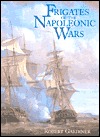

 |

|

The average rating for Frigates of the Napoleonic Wars based on 2 reviews is 4 stars.
Review # 1 was written on 2014-11-14 00:00:00 Alberto Zayas Alberto ZayasA frigate during the “age of fighting sail” is roughly the 18th and early 19th century equivalent of the modern naval destroyer, the ideal command in the minds of most zealous captains, then and now -- small enough not to be expected to stand in the line of battle, large enough to be capable of formidable and dashing independent service. And that meant one-on-one actions against the enemy and the prospect of prize money. Unfortunately for modern naval historians and fans of Patrick O’Brian and C. S. Forester, no standard-size frigates of the Napoleonic period have survived, only ships of the line like Victory. (The Constitution, though called a “frigate,” is much larger than the classic design, a compromise resulting from the American need for a navy with the lack of funds to build a large one.) This is the author’s third book about frigates and was meant to be part of a series, but was recast as a stand-alone volume. Except that it still seems to pick up in the middle of the subject; the first chapter is even called “The Return to Moderate Dimensions,” with no indication what the earlier dimensions of a frigate were. And coverage is exclusively on British-built ships, except for refitted captured vessels. Six chapters on overall frigate design up through 1815 are followed by six more on the design, construction, performance, and armament of individual ships -- or of ship classes, actually, as there were far too many frigates built to discuss the details of their numerous variations individually. The writing itself is academically precise and quite technical, wending among a large number of tables, hull design drafts, and specialists’ working drawings. No effort is made to define or explain terms like “spar-deck armament,” “hollow waterline,” or even “scantlings” (to a comparison of which considerable discussion is devoted). This is definitely not a book for the beginner, even one familiar with square-rigged ships. I must say that many of the included original designers’ plans are also less than useful because the cutlines often refer to points discussed in the holographic notes in the drawings which are reproduced at a size too small to be read. For me, the best part of the book is at the very end, Chapter 12, “Frigates in Action,” which discusses the application and result of all that abstruse architecture and skilled building, with sections on the frigate’s role in independent, squadron, and fleet action, the function of such ships in reconnaissance and in intelligence-gathering and in blockade duty off the French coast, and the key part they played in coastal and amphibious operations generally, where ships of the line were simply too large and too inefficient in their seakeeping to be trustworthy. Still, I suspect this book will be most useful to students of naval architecture and to builders of detailed, large-scale models. |
Review # 2 was written on 2019-08-22 00:00:00 thomas garrera thomas garreraBeautifully written, the narrative keeps pace with the tumultuous events and the often mundane existence aboard an ocean going vessel. A lot of the apocrypha surrounding the Captain is thankfully dispersed and replaced by a much more humane and credible account. |
CAN'T FIND WHAT YOU'RE LOOKING FOR? CLICK HERE!!!